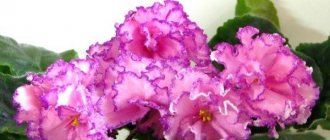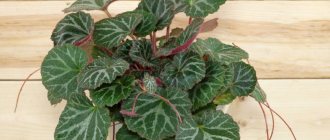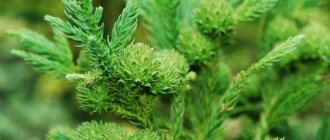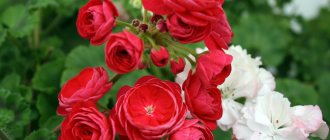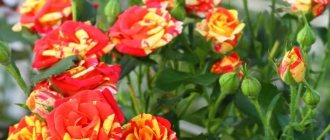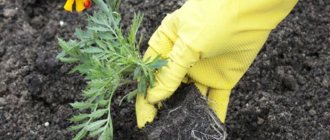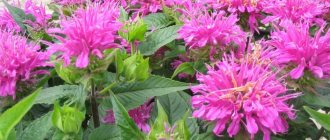How to grow Datura flower in a garden plot, why it is dangerous for humans, features, differences and important points will be discussed later in this article.
The Datura flower has huge bell-shaped buds and a wonderful, enveloping aroma. This is a real find for any garden.
It pleases with its unusual appearance all summer and early autumn. The plant is so loved by the people that it has different names.
It is sometimes called datura, water drinker, witch's herb or devil's herb.
Chemical composition of Datura
Dried datura leaves contain: atropine, hyoscyamine, scopolamine.
The content of essential fatty oil in yellow dope seeds is 25%.
German scientists first discovered daturine in Datura leaves in 1831.
Other isolated Datura alkaloids: meteloidine, norgioscyamine, pseudotropine, tigloidine, tropine.
Application in medicine
The use of the Datura plant in medicine is determined by its presence in a set of natural medicinal preparations. For example, ophthalmologists use the isolated chemical component of the plant, atropine, to medicinally diagnose the eyes by dilating the pupil.
Doctors use Datura leaves to treat bronchial asthma, bronchitis, convulsive cough and in cases where drugs with anticholinergic properties are needed to cure the disease. As far as we know, a stomach ulcer is manifested by severe pain, frequent gag reflex, heartburn and pain that disappears after eating.
This disease can only be cured with an integrated approach, which includes drug treatment.
The most common is atropine sulfate, which includes datura, belladonna and henbane.
The effect of the drug will be as follows: it will calm, anesthetize, relax, suppress the work of the large digestive and salivary glands of the system, normalize the functioning of the stomach, and relieve tension from all the smooth muscles of the internal organs. In addition, the attending physician prescribes proper nutrition and daily routine.
Datura preparations are used for the prevention and treatment of bradycardia, bronchial asthma, angina pectoris, and hypersecretion of the sweat and lacrimal glands. It provides good supportive therapy for inflammatory diseases such as iritis, keratitis and many others.
In case of the last degree of poisoning with cholinomimitric, anticholinesterose and organophosphorus, morphine-like and many other substances, atropine is primarily prescribed at a dosage of 0.1% intravenously. In folk medical practice, Datura is used for prolapse of the uterus and rectum, and also helps with tumors, acting as a strong pain reliever.
Feeding for datura
It is necessary to apply organic fertilizers with the addition of mineral fertilizers weekly.
During flowering, Datura needs more phosphorus and potassium supplements. After 2 months of growth, some nitrogen fertilizer should be added.
Plants that winter without lighting do not need feeding.
Parasite mixture
Around the world, about 40% of the population is infected with helminths, which creates a constantly depressed state of the body as a whole. Many people attacked by parasites constantly visit doctors, take blood tests, but cannot find the cause of their illness.
Datura grass, a photo and description of which can be found in any botanical reference book, is a poisonous plant that can only fight those parasites that live in the lungs and eyes of humans.
These include:
- intestinal eels;
- roundworms;
- cysticerci;
- pulmonary flukes;
- Schistostoma.
Datura herb also cleanses the body well. Cleaning Datura with grass from parasites can be done at home.
To do this, several easy methods have been created, descriptions with photos of which are given below:
- It is necessary to pour fresh or dry dope leaves onto an iron baking sheet and put on fire. As soon as smoke begins to emerge, you need to inhale quickly and deeply, keep your eyes open, and get as close as possible to the source of the smoke. As soon as slight dizziness appears, you should abruptly stop the procedure and ventilate the room in order to avoid visual hallucinations from the therapy.
- The second method involves having a small type of room with an electric stove. This method will be much more effective than the first, because the entire space will be treated with smoke. To carry out the therapy, they put on unnecessary clothes, take a frying pan and fry the herbs in this room until the room is completely filled with smoke. As soon as a slight degree of intoxication is felt, they immediately go out and change clothes, and ventilate the room.
- The latter method promises cost savings, as it involves smoking weed through a half-liter plastic bottle using foil. The bottle is bent in half, a hole is burned in the lower part, and the upper part is covered with foil and reinforced to ensure the strength of the product. Poke 8 holes on the foil with a needle and pour in dry crushed grass, then set it on fire and draw in the smoke.
At the end of one of the listed procedures, the parasites will leave the body by being released from the eyes or throat.
Pests and diseases of Datura
Whitefly and spider mites are the main enemies of Brugmansia. Mandatory spraying of the inner parts of the bushes with insecticides should be carried out monthly in winter and summer.
Asthma remedy
Datura herb, photos and descriptions of which can be found on the Internet, has been used in traditional medicine recipes for a long time. And this healing plant will quickly help in the treatment of bronchial asthma.
At the moment, there are 3 ways to combat the disease:
- A mixture of 7 parts datura leaves powder, 1 part henbane, 1 part sodium nitrate, 2 parts belladonna leaves. This powder can be burned and inhaled, or smoked like a cigarette.
- They produce cigarettes called Astmatin - 2 parts henbane, 1 part sodium nitrate and 8 parts dope.
- A decoction of Datura leaves is used to inhale the vapors through the nose. The principle is the same as in the treatment with boiled hot potatoes.
Beneficial medicinal properties of datura
They learned how to prepare various alcoholic tinctures, extracts and extracts from Datura.
In different countries they have learned to use the “mad potion” to treat convulsions, seasickness, bronchial asthma, and air sickness. Many countries use datura as an antispasmodic, antidepressant, and analgesic. Surgery has long recognized the analgesic effect of Datura and uses it widely. Datura oil is used to treat radiculitis, rheumatism and neuralgia. You can get rid of unwanted hair forever with the help of devil's grass oil extract.
Contraindications
After consuming 20-25 dope seeds, after 10 minutes the dryness in the mouth becomes such that it is impossible to even swallow saliva. The voice changes, the pressure rises, hoarseness appears. The skin becomes hot and loses sensitivity, the pupils dilate, and there is lethargy and weakness. A person begins to communicate with non-existent people, as if swatting away flies. A few days after dope poisoning, there is a feeling of fear, anxiety, blurred vision, and fussiness.
3.Varieties:
3.1.Datura stramonium
An annual tall herbaceous plant that can reach 60 - 150 cm in height. It has a vertical, powerful, thick, abundantly branched stem. The leaves are green, serrated, reach a length of 20 cm; when damaged, the leaves and stems emit a foul odor. The leaf blades are dark green, with a lighter green tint on the underside. The flowers are funnel-shaped, with fused petals, very attractive, have a pleasant aroma, reach a diameter of 70 cm, and open at night. Flower colors include white, cream, and purple. After flowering, the plants form small oval seed capsules with a diameter of 3 to 8 cm, covered with numerous sharp spines.
↑ Up,
3.2. Indian Datura - Datura metel
Depending on the climate, these large-flowered plants can be either annual or perennial, reaching a height of 90 cm. The stems are strong, offensively branched, often covered with slight pubescence. The leaves are glossy, dark green, up to 20 cm long, with large teeth along the edges and a whole network of leaf veins. The veins on the surface of the leaf plates are highlighted in a lighter shade. The flowers are very large, solitary, reaching a diameter of 15 to 20 cm, have a pleasant aroma, open in the evening and at night, and can be single or double. Flower colors include white, yellow, lilac, dark purple and pink. The outer side of the petals has short pubescence.
↑ Up,
3.3. Tree dope or brugmansia - Brugmansia
Brugmansia is a climbing vine with long stems, on which dark green oblong-oval leaves are alternately located. Some varieties have denticles along the edge of the leaf blade and leaves covered with fine hairs. In summer, buds appear at the ends of the branches, which subsequently turn into white, pink or yellow tubular magnificent, often single flowers up to 25 cm long. The flowers have a strong scent, sometimes with citrus notes, which intensifies in the evening and fills the entire room. Brugmansia differs from Datura in that its flowers seem to droop, while those of Datura are arranged vertically. There are variegated forms of Brugmansia.
↑ Up,
Side effects
Systematic use of small doses can lead to very unpleasant sensations:
- Nausea and vomiting.
- Veins swell.
- My head is spinning.
- Dryness of all mucous membranes appears.
- Tachycardia.
With continuous use of dope, the following may occur:
- Psychical deviations.
- Diarrhea.
- Nervous tension and anxiety.
- Memory impairment.
- Eye diseases begin to develop.
Medical institutions aimed at curing various types of intoxications in the human body believe that most of the poisonings occur due to the use of grass, and even a small dose of ingestion of the plant is fraught with serious consequences.
Plant care
The main care for dope consists of watering, pruning, and disease control. Loosening the soil and removing weeds is required for the first month until the plant has branched shoots covered with large leaves and buds. Shade and aroma inhibit the growth of weeds near the datura.
Watering
The difference between Datura and flower crops is that it needs hard water. In its absence, the datura is watered 1-2 times a summer with lime water prepared from 10 grams of dry slaked lime and 10 liters of water. Once a week, add 20 grams of complex mineral fertilizer to a bucket of water.
The plant does not tolerate dry soil and drops its buds. The soil must be moistened abundantly. The frequency of watering depends on the air temperature and the amount of precipitation.
Trimming
The fading “gramophones” are removed so that the datura bush looks just as elegant and to stimulate new budding. To obtain seeds, leave a few of the very first flowers to bloom. Full ripening of the ovaries occurs 60 days after the start of flowering.
Pruning is carried out in 2 cases: when grown as a perennial and when stored indoors in the winter. The perennial leaves its youngest shoots at the end of September, forming the future crown.
Top dressing
Once a week from June to August, 20 grams of complex mineral fertilizer are added to a bucket of water. Organic fertilizers alternate with mineral ones if there is not enough humus in the soil where Datura was planted.
See also
Description of varieties and types of sedum flower, planting and care in open groundRead
Wintering
In regions with cold winters, annual datura can be dug up and placed in a spacious pot with a nutrient mixture. Pruning is done first to form a crown of young shoots. Plants are placed in a cool room where the temperature does not rise above +15 and does not fall below +8 degrees.
Datura sheds its leaves, but remains viable.
In the spring, after transplanting into the ground, new leaves appear, shoots grow and buds bloom.
Features of use during pregnancy and breastfeeding
During the period of bearing a baby, a woman should take care of her health as much as possible. But no one is immune from unwanted diseases, and often drug treatment is successfully replaced by folk remedies.
But there is no need to rush to brew and use various familiar herbal mixtures, as this can significantly harm the baby during intrauterine development, and even lead to spontaneous abortion. Toxic substances in the datura herb can cause a sharp decrease in oxygen in the mother's blood and cause asphyxia of the fetus or its death.
It is important to follow the recommendations of a doctor , who individually selects the dosage of using the herb for each person.
History of the Datura flower: which plant family does it belong to?
Datura is a flower that scientists classify as a plant endowed with pharmacological properties.
It is known throughout the world as a powerful hallucinogen, but it is used in folk, homeopathic and even traditional medicine.
Numerous types of dope belong to the nightshade family, which includes belladonna, tobacco, and henbane, which contain narcotic alkaloids.
If we analyze dope, scientists identify 4 main types of this plant:
- common datura;
- Indian datura;
- Indian datura;
- strong-trunked datura.
However, among botanists there is no established classification of the plant, so it is impossible to determine the total number of daturas existing today. Just as there is no exact understanding of where datura was first discovered.
Many scientists believe that the homeland of this perennial is Mexico and Central America. But datura was brought to Europe along with other types of nightshades: potatoes, tomatoes, tobacco. Another part of scientists believe that datura was first found in the Caspian steppes and only then were brought to other continents during the migration of gypsies.
How to propagate
For propagation, cuttings are used. The shoots are cut off at the end of September. There should be 2-3 internodes on the cut. The lower leaves are removed. You can root in water or soil mixture, in good light and a temperature of at least 20 degrees.
In mid-May, rooted cuttings are planted. Planting seedlings with soil occurs using the transshipment method. The pre-watered plant is removed from the container and transferred to the prepared hole. Sprinkle with soil and water again.
Growing Datura flower from seeds at home
If Datura is propagated by seeds, then the optimal time for planting the plant is from February to April. Before directly planting the seeds, you need to fill them with hot water to weed out material unsuitable for sowing.
It is necessary to sow seed material in soil made of peat and sand, which needs to be filled with a wooden box. Next, it is important to recreate greenhouse conditions - gently cover the top of the pot with film and hide it in a dark place. The air temperature should not exceed 22°C.
After the first shoots appear, the film is removed from the box and the pot is moved to a lighted place.
When full-fledged leaves appear on the plant, it can be planted in separate pots.
Contraindications
Datura herb, the photo and description of which is known to many scientists, is a very poisonous plant; it is prohibited for people who have:
- Glaucoma.
- Pregnancy is progressing.
- Breastfeeding period.
- Individual intolerance.
Seeds germinate faster! ↑
Planting and growing datura is very easy! There are a huge number of seeds of various varieties on the planting material market. Any self-respecting company will definitely hide the treasured 3-4 seeds in a multi-colored bag.
The seeds are quite large, covered with a dense seed coat. Germination is very high - 95%, lasts up to 10 years.
One obstacle is that you usually have to wait a very long time for the first shoots, sometimes up to 30 days.
To speed up this cute miracle of nature a little, you can soak the seeds in cool water or a growth stimulant solution for a couple of days. This will help to loosen the tight shackles of the seed coat a little and give light to new green life faster. Practitioners recommend using a ziplock bag with a small amount of water. Place the seeds there and wait until they hatch, then feel free to plant them in the ground and enjoy the seedlings.

